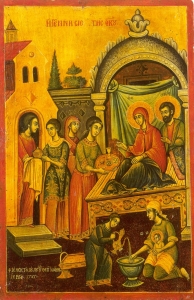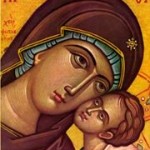Arriving December 25 2010
Christ is Born…. Glorify Him!
]]>
Father George Bithos' weblog
Christ is Born…. Glorify Him!
]]>Question: How are the Old and New Testament related? This time of year is the best time to ask this question. As we prepare to celebrate the Nativity in the Flesh, the best thing we can ask is what relationship between the two parts of the Bible. For we Orthodox, the Old and New Testaments are inexorably linked. The Old Testament is the foretelling of the New. It holds up a mirror to Christ and to all the individual features of his life. What do I mean? Shall we look at the details?
These details of the Nativity show how God prepared the world through His prophets. The Old Testament provides us Christ in shadow and in smoke. The word that the Church uses for this relationship is foreshadow. The arrival of the Messiah was an event for which God had to prepare the world. Christmas is two days away, are you spiritually prepared?
]]>
Question: Do I know what the Church is? This might at first appear to be a foolish questions to ask, but I do not ask it lightly. Most of us adults in the Church are too embarrassed to admit we don’t understand. What don’t we understand? We don’t know what the Church is! Perhaps, the most basic question we should ask is: “Do we have a personal relationship with Christ?” Ours is a personal God who came to earth, being born in a manger, so that each of us could enjoy a personal relationship with Him. After His crucifixion and resurrection, He sent His Holy Spirit to empower us; so that we could truly live. With our Baptism, we become new creatures in Christ, free of sin. With our Chrismation, we are given, as a free gift, His Spirit to allow us to grow in Him. By partaking in Holy Communion, we become united to Christ. The added dimension is that we are also united to everyone who participates in His Body and His Blood. The Church is actualised when we, as the faithful, come together and become the Body of Christ. Through God’s Holy Spirit, we are no longer lonely individuals. We become personally united with Christ and through Him with each other. The Church transcends time and space. It has a cosmic dimension that connects us with Him and all Christians. This bond is not limited by physical death, time or place. The Church is Christ and all who are joined with him. This miracle is a mystery of faith. As St. Paul explains in his Letter to the Hebrews: “Now faith is the assurance of things hoped for, the conviction of things unseen” (Hebrews 11, 1). We cannot see the Church, yet it is! It is for us the ultimate reality; the Kingdom of God on earth and a foretaste of heaven. This is as personal a relationship that we could ever experience. Once again, St. Paul says it best, “ I have been crucified with Christ; it is no longer I who live, but Christ who lives in me; and the life I now live in the flesh I live by faith in the Son of God, who loved me and gave Himself for me.
]]>
“Can you tell me the differences between the Roman Catholic Church and our Church?’ I cannot tell you how often I have been asked this question! Well, today is a big part of that answer. Today, we commemorate The Conception of the Theotokos by Saints Anna and Joachim. Last night, I wrote about this holy couple’s great desire to have God intercede in their lives, listen to their prayers and bless them with a child. Not unlike Sara and Abraham and other Old Testament couples, Joachim and Anna were advanced in age, perhaps too advanced. But, God did heard their prayers and allowed them to conceive. This is the first important point that must be noted, the Virgin Mary was conceived in the normal biological manner; the product of the loving union between a husband and wife. God’s blessing and the intervention of His Holy Spirit enabled this to happen. This is one of the reasons Joachim and Anna are the image of married bliss for Orthodox couples. The Conception of the Theotokos is a source of another divergence in theology between Orthodoxy and Catholicism. We, Orthodox, do not believe in the “Immaculate Conception of the Virgin Mary.” We must be very careful here! We (Orthodox) DO believe that Our Lord Jesus Christ was Immaculately Conceived. Christ being Fully God and Full Man was born without sin. God can not have sin. But this was not the case for his mother, the Theotokos. The Orthodox Church teaches that Mary was born with sin, just as all of humanity. Furthermore, the Church believes that Mary lived a life of purity and she found favour with God because of her righteousness. She was cleansed of her sin by the Spirit of God at the Annunciation, so that she could carry the Christ Child within her body. Turning to the Roman Catholic understanding, it started to divert from the Orthodox very early. The Western Church began to develop the teaching of the Immaculate Conception of the Virgin. Their teaching states that God, fore-knowing, that Mary would bear the Christ; provided that she was born without sin. This teaching was a pious belief until 1854, when Pope Pius lX declared the teaching – dogma of the Catholic Church. This decree was then ratified by Vatican I in 1870. So we can see this is a relatively new doctrine. This is a rather simplistic explanation. There are other deeper theological implications, but nonetheless, the Immaculate Conception of the Virgin Mary is a major area of theological disagreement between the two Churches.]]>
Today is one of those days of preparation that the Church provides us to get ready for a holiday. Tomorrow, we commemorate the Conception of the Theotokos. Today, we get ready. We have an opportunity to pause and consider the importance of the coming event. Where should we look for a better understanding of the feast? Like many feasts of the Church this occurrence is not documented “in the Bible,” yet it is a significant happening in salvation history. Where does one go to learn about this festival? Where do you start? I decided to ask this question out loud; so that we could learn from each other. We know that the hymns of the Church describe the theology of a feast. What do they say? The Troparion sung at the Vespers for tomorrow speaks of the “bonds of barrenness being loosed” and of the “prayers” of Joachim and Anna asking for “birth beyond hope.” What do these clues tell us? If we read closely, we see that this couple was without children and beyond the hope of having children, they prayed for God to change their life. In an earlier post, we stated that many of our hymnographers got inspiration from the other writings, from the Christian Apocrypha. The book, the Protevagelium of James, (The Infancy Gospel of James) tells us the story of the birth of the Virgin Mary. We read in the first part of this book about the “prayer of St. Anna.” In her garden, Anna turns to God in her prayer. She describes her barren womb as contrasted to the fruitfulness of the natural creation. Anna begs Our Lord to bless her and allow to “bring forth fruit in her season.” An angel of the Lord appears to St. Anna and informs her that God has heard her prayer. He tells her that she would conceive and give birth to a child. In gratitude, Anna pledges to dedicate her child as a gift to God, since it would be a gift from God. Not only are these ancient sources inspiration for hymnographers; but also for iconographers (as we can see above). The child, which the angel announces is conceived as every child is, as a blessing from God; but this child is a blessing for all of humanity. ]]>
Μεγαλύνει ἡ ψυχή μου τὸν Κύριον
καὶ ἠγαλλίασεν τὸ πνεῦμά μου ἐπὶ τῷ Θεῷ τῷ σωτῆρί μου,
ὅτι ἐπέβλεψεν ἐπὶ τὴν ταπείνωσιν τῆς δούλης αυτοῦ.
ἰδού γὰρ ἀπὸ τοῦ νῦν μακαριοῦσίν με πᾶσαι αἱ γενεαί,
ὅτι ἐποίησέν μοι μεγάλα ὁ δυνατός,
καὶ ἅγιον τὸ ὄνομα αὐτοῦ,
καὶ τὸ ἔλεος αὐτοῦ εἰς γενεὰς καὶ γενεὰς
τοῖς φοβουμένοις αυτόν.
Ἐποίησεν κράτος ἐν βραχίονι αὐτοῦ,
διεσκόρπισεν ὑπερηφάνους διανοίᾳ καρδίας αὐτῶν·
καθεῖλεν δυνάστας ἀπὸ θρόνων
καὶ ὕψωσεν ταπεινούς,
πεινῶντας ἐνέπλησεν ἀγαθῶν
καὶ πλουτοῦντας ἐξαπέστειλεν κενούς.
ἀντελάβετο Ἰσραὴλ παιδὸς αὐτοῦ,
μνησθῆναι ἐλέους,
καθὼς ἐλάλησεν πρὸς τοὺς πατέρας ἡμῶν
τῷ Αβραὰμ καὶ τῷ σπέρματι αὐτοῦ εἰς τὸν αἰῶνα
______________________________________________________________________________________________________
My soul magnifies the Lord,
and my spirit rejoices in God my Savior;
For he has regarded the lowliness of his handmaiden.
For behold, from this day all generations will call me blessed;
For the mighty one has done great things to me, and holy is his name.
And his mercy is on those who fear him from generation to generation.
He has shown strength with his arm;
He has scattered the proud in the imagination of their hearts;
He has cast down the mighty from their thrones and has exalted the holy;
He has filled the hungry with good things,
and the rich he has sent empty away.
He has helped his servant Israel,
in remembrance of his mercy,
as he spoke to our fathers,
to Abraham and to his seed forever.
Even though the number of times we encounter the expectant Virgin are very rare; our humble reaction should echo Elizabeth’s exclamation. “Blessed are you among women, and blessed is the fruit of your womb! ]]>

Today, I’d like to share a miracle which came into our life. God provided us an example of his great love. We shared in the blessing of life. Today, our new grandbaby arrived. He is number five. He joins his three little girl cousins and his big brother, Vassili, but he is the first to grace us while I am doing this blog. It seems only right to share some reflections on him joining our family. The truth is ever since we learned that Katina, our daughter, and Vastan, our son-in-law were expecting, we have been praying for them and the new baby.
[caption id="attachment_244" align="alignright" width="105" caption="Peter"] [/caption]
When we learned the baby was going to be a boy he acquired a name, Peter Nicholas. The little guy was going to be named for his two uncles, one on each side of the family. Little Peter has been a topic of great speculation. When exactly would he come, how much he would weigh, how big would he be? Well, today we got all our questions answered. He made his appearance on February 21, 2009, he is 191/2” long and he weighs 7.4lbs.
[/caption]
When we learned the baby was going to be a boy he acquired a name, Peter Nicholas. The little guy was going to be named for his two uncles, one on each side of the family. Little Peter has been a topic of great speculation. When exactly would he come, how much he would weigh, how big would he be? Well, today we got all our questions answered. He made his appearance on February 21, 2009, he is 191/2” long and he weighs 7.4lbs.
I once heard that a baby was proof positive that God is love. This is one of the most simple and most profound statements we could consider. St. John the Evangelist states so plainly, “God is love” (1John 4, 8). Our God is a community of love, a constant exchange of love between the three persons of the Holy Trinity. A new life is a reflection of that love. Here on the desk is an icon of the Glukofilousa, (The Sweet Kissing Virgin). What a beautiful expression of love between the Theotokos and Christ, what peace, what perfect joy. Here into our life, that joy is revealed once more.  We need to be open to God’s love, to allow it to permeate our soul and to have appreciation for it when it comes. This can happen not only in the big events, like the birth of a new baby; but in the little things. That is the challenge, stopping to recognize God revealing Himself and His love to us and letting that blessing soften our heart and bring joy into our life. Look at your life. Has God revealed Himself and His love to you? Maybe He has, but you were too busy or preoccupied to notice. The pace of life is so fast that many times we can not recognize the love of God. It may be that small event, that person we meet or the opportunity to open our own heart; yet we do not cherish the moment or perceive the encounter with the love of God. St Silouan the Athonite prayed, “O Lord, by Your Holy Spirit enlighten Your people that all may know Your love.”
We need to be open to God’s love, to allow it to permeate our soul and to have appreciation for it when it comes. This can happen not only in the big events, like the birth of a new baby; but in the little things. That is the challenge, stopping to recognize God revealing Himself and His love to us and letting that blessing soften our heart and bring joy into our life. Look at your life. Has God revealed Himself and His love to you? Maybe He has, but you were too busy or preoccupied to notice. The pace of life is so fast that many times we can not recognize the love of God. It may be that small event, that person we meet or the opportunity to open our own heart; yet we do not cherish the moment or perceive the encounter with the love of God. St Silouan the Athonite prayed, “O Lord, by Your Holy Spirit enlighten Your people that all may know Your love.”